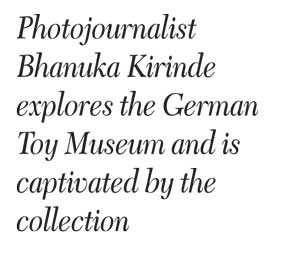Thursday Nov 13, 2025
Thursday Nov 13, 2025
Saturday, 17 October 2015 00:08 - - {{hitsCtrl.values.hits}}

Dr. Gayangi von Heimendahl
 Collecting toys began as a hobby for Dr. Gayangi von Heimendahl and her family in 1977 in Germany. As the collection grew through the years, Gayangi, who had moved to Germany in the early 1970s for her higher studies, opened up a toy museum with the help of a couple of friends in the city of Traunstein.
Collecting toys began as a hobby for Dr. Gayangi von Heimendahl and her family in 1977 in Germany. As the collection grew through the years, Gayangi, who had moved to Germany in the early 1970s for her higher studies, opened up a toy museum with the help of a couple of friends in the city of Traunstein.
Years later, Gayangi decided to move back to Sri Lanka along with her wonderful collection of toys and started the German Toy Museum which is located down Havelock Road, Colombo 6. Today any visitor to the museum can see the extensive collection of valuable German toys, each encompassing an interesting tale of its own.
“As I began to collect toys, I wanted to know more about each of them and hence I began to study about the art of toy making and realised that these miniature objects have a lot more than what meets the eye,” she said. ”By observing the architecture of each toy, a person could create a mental image of the varying types of raw material used during the years in which they were manufactured,” Gayangi added.
The toys depict many everyday scenes. They show butcher shops, grocery stores and flower shops to name a few. There are also the famous penny toys which were the cheapest toys available. They were simply made by cutting thin sheets of metal and then carved out and painted into miniature objects like carts and horse carriages. Penny toys were manufactured widely in Germany between the 1880s and 1914 and were sold in the United Kingdom for one penny, hence the name.
The model trains that Gayangi has collected are impressive and show visitors the various models of trains of the 20th century which are owned mostly by serious collectors. The model automobiles, which include cars, vans and caravans, also fall under collector’s items.
The museum contains toys that were manufactured in Germany as far back as 1850 and up to the 1970s. Each set of toys gives us a brief idea of what children used to play with and how toys evolved overtime. Doll houses show various types of houses people used to occupy and the clothes of those inhabiting them show how people dressed and lived during different eras. “A close study of toys shows us how society progressed over the years,” she explained.
A special item that is likely to catch the eye of any visitor is the model train set on display that dates back to the 19th century and is a replica of the actual train used by Germans during that period.
Visitors to the German Toy Museum can enjoy an audio tour too, which gives a good briefing about the origin of the toys and the stories behind them. Each toy has been created in a manner that children playing with them can develop logical reasoning from an early age. When it comes to toy making skills, one would be hard-pressed to find any competition for the Germans.
The German Toy Museum is located at 421, Havelock Road, Colombo 6.
Pix by Bhanuka Kirinde

